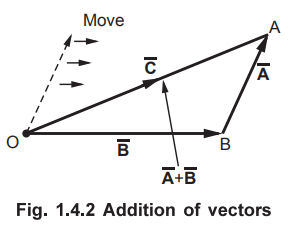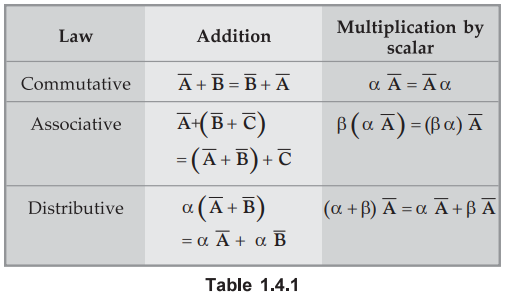Electromagnetic Theory: Unit I: (a) Vector Analysis
Vector Algebra
Scaling, Addition, Subtraction
• The various mathematical operations such as addition, subtraction, multiplication etc. can be performed with the vectors. In this section the following mathematical operations with the vectors are discussed.
Vector
Algebra
•
The various mathematical operations such as addition, subtraction,
multiplication etc. can be performed with the vectors. In this section the
following mathematical operations with the vectors are discussed.
1.
Scaling 2. Addition 3. Subtraction.
1. Scaling of vector
•
This is nothing but, multiplication by a
scalar to a vector. When a scalar is
positive then such a multiplication changes the magnitude (length) of a
vector but not its direction.
•
Let α = Scalar with which vector is to be multiplied
•
Then if α >1 then after multiplying to a vector the magnitude of a vector
increases but direction remains same. If α <1 then after multiplying to a
vector the magnitude of a vector decreases but direction remains same.
•
If α = -1 then after multiplying to a vector the magnitude of vector remains same but direction of the vector reverses.
Key Point : Thus
if a is negative, the magnitude of vector changes by a times while the
direction becomes exactly opposite to the original vector, after
multiplication.
2. Addition of Vectors
•
Consider two coplanar vectors as shown in thw Fig. 1.4.1. The vectors which lie
in the same plane are calles Coplanar
vectors.
•
Let us find the sun of these two vectors  shown in the Fig. 1.4.1.
shown in the Fig. 1.4.1.

•
The procedure is to move one of the two vectors parallel to itself at the tip
of the other vector. Thus move ![]() , parallel to itself at the tip of
, parallel to itself at the tip of ![]()
•
Then join tip of ![]() moved, to the origin. This vector represents resultant
which is the addition of the two vectors
moved, to the origin. This vector represents resultant
which is the addition of the two vectors ![]() and
and ![]() . This is shown in
the Fig. 1.4.2.
. This is shown in
the Fig. 1.4.2.

•
Let us denote this resultant as ![]() then
then

•
It must be remembered that the direction of ![]() is from origin O to the tip
of the vector moved.
is from origin O to the tip
of the vector moved.
•
Another point which can be noticed that if ![]() is moved parallel to itself
at the tip of
is moved parallel to itself
at the tip of ![]() , we get the same resultant
, we get the same resultant ![]() Thus, the order
of the addition is not important. The addition of vectors obeys the commutative
law i.e.
Thus, the order
of the addition is not important. The addition of vectors obeys the commutative
law i.e.  .
.
•
Another method of performing the addition of vectors is the parallelogram rule. Complete the
parallelogram as shown in the Fig. 1.4.3. Then the diagonal of the
parallelogram represents the addition of the two vectors.

•
Once the co-ordinate systems are defined, then the vectors can be expressed in
terms of the components along the axes of the co-ordinate system. Then by adding
the corresponding components of the vectors, the components of the resultant
vector which is addition of the vectors, can be obtained. This method is
explained after the co-ordinate systems are discaussed.
•
The following basic laws of algebra are obeyed by the vectors  :
:

•
In this table α and β are the scalars i.e. constants.
3. Subtraction of Vectors
•
The subtraction of vectors can be obtained from the rules of addition. If ![]() is to be subtracted from
is to be subtracted from ![]() then based on addition it can be represented as,
then based on addition it can be represented as,

•
Thus reverse the sign of ![]() i.e. reverse its direction by multiplying it
with -1 and then add it to
i.e. reverse its direction by multiplying it
with -1 and then add it to ![]() to obtain the subtraction. This is shown
in the Fig. 1.4.4 (a) and (b).
to obtain the subtraction. This is shown
in the Fig. 1.4.4 (a) and (b).

a. Identical Vectors
•
Two vectors are said to be identical if
there difference is zero. Thus  are identical if
are identical if  .
Such two vectors are also called equal
vectors.
.
Such two vectors are also called equal
vectors.
Electromagnetic Theory: Unit I: (a) Vector Analysis : Tag: : Scaling, Addition, Subtraction - Vector Algebra
Related Topics
Related Subjects
Electromagnetic Theory
EE3301 3rd Semester EEE Dept | 2021 Regulation | 3rd Semester EEE Dept 2021 Regulation
